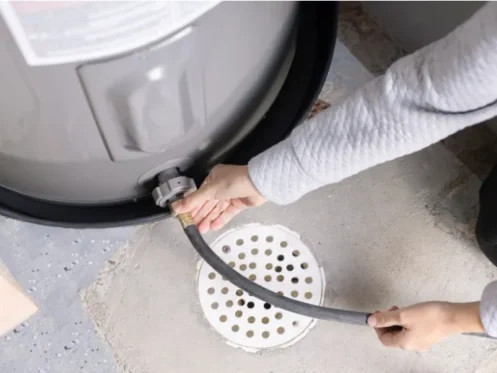Flushing your water heater is an important part of keeping it running smoothly. Over time, sediment and minerals build up inside the tank, reducing efficiency and potentially causing damage. Whether you have a traditional or tankless water heater, regular flushing helps keep the system clean and your hot water flowing reliably. By following a few simple steps, you can extend the life of your unit, improve performance, and avoid costly repairs down the road.
Why Is It Important to Flush Your Water Heater?
Over time, sediment, minerals, and debris accumulate at the bottom of your water heater. This buildup can reduce heating efficiency, clog pipes, and cause the heater to work harder than necessary. Regular flushing prevents these problems and helps extend the life of your unit.
For those in Southwest Florida, where hard water is common, flushing your water heater should be done at least once a year to avoid significant sediment buildup.
How to Flush a Water Heater (Traditional Tank)
Flushing a traditional tank water heater is straightforward, but it’s important to follow the right steps to ensure a safe and effective process. Here’s how to flush your hot water heater:
1. Turn Off the Power Supply
- Gas Water Heater: Turn the gas valve to the “pilot” setting.
- Electric Water Heater: Turn off the breaker at the electrical panel to cut power to the unit.
2. Turn Off the Water Supply
Locate the cold water inlet valve at the top of the tank and turn it off. This prevents more water from entering the tank while you flush it.
3. Connect a Hose to the Drain Valve
At the bottom of the water heater, you’ll find the drain valve. Attach a garden hose to this valve and place the other end of the hose in a safe drainage area, such as outside or in a floor drain.
4. Open the Drain Valve
With the hose securely connected, open the drain valve to allow the water and sediment to flow out. Be cautious, as the water will be hot! Allow the water to flow until it runs clear, indicating that most of the sediment has been removed.
5. Flush with Cold Water
Once the tank is mostly drained, turn on the cold water supply for a few minutes to stir up any remaining sediment and flush it out through the drain valve. This final rinse helps clear the tank completely.
6. Close the Drain Valve and Refill the Tank
After flushing, close the drain valve and remove the hose. Turn the cold water supply back on and let the tank refill. Make sure to check for any leaks around the drain valve.
7. Restore Power or Gas
Once the tank is full, restore power to the water heater by turning the breaker back on (for electric units) or switching the gas valve back to the “on” position (for gas heaters). Wait about 30 minutes for the water to heat back up.
Tips for Flushing a Tankless Water Heater
Tankless water heaters, which heat water on demand, also need regular flushing to remove mineral deposits, especially in areas with hard water like Southwest Florida. However, the process is slightly different. Here’s how to perform a tankless water heater flush:
1. Turn Off Power and Water Supply
Shut off the power to the tankless unit and close the cold and hot water isolation valves.
2. Connect Hoses to the Service Ports
Attach hoses to both the hot and cold service ports on the water heater. These ports allow for easy access to flush the system.
3. Use a Flushing Kit
Using a tankless water heater flush kit (available at most hardware stores), circulate white vinegar through the system for about 45 minutes to break down mineral buildup. The vinegar helps dissolve calcium and other sediments inside the unit.
4. Rinse and Reconnect
After the flush, disconnect the hoses and close the service ports. Open the cold and hot water isolation valves, turn the power back on, and run water through the system to ensure it’s working correctly.
How Often Should You Flush Your Water Heater?
- For Traditional Tank Water Heaters: Flush your water heater once a year to remove sediment and prevent clogs. In areas with hard water, like Southwest Florida, you may want to flush your heater every 6 months.
- For Tankless Water Heaters: A tankless water heater should be flushed at least once a year. If you notice reduced water flow or a change in water temperature, it might be time for a flush sooner.
Benefits of Flushing Your Water Heater
- Improved Efficiency: A clean water heater heats more effectively, saving energy and reducing your utility bills.
- Extended Lifespan: Regular flushing prevents sediment buildup, which can damage heating elements and reduce the life of the unit.
- Better Water Quality: Removing sediment improves the taste and clarity of your hot water, making it healthier for you and your family.
Need Help with Your Water Heater?
Flushing your water heater is a simple task, but it can be time-consuming or tricky if you’re unsure of what you’re doing. At Spartan Plumbing, our licensed professionals are here to help you with water heater maintenance, whether you have a traditional or tankless system. We’ll flush your heater, inspect for potential problems, and ensure everything is running smoothly.
Contact Spartan Plumbing today to schedule your water heater flush and keep your system working at peak efficiency!


